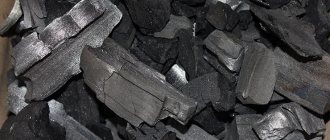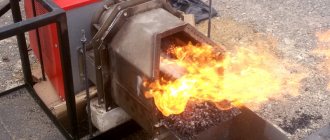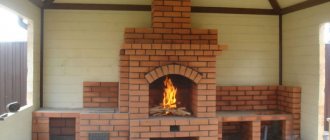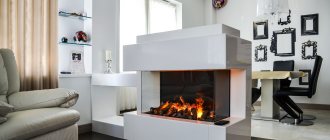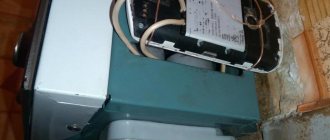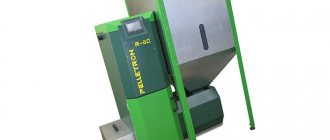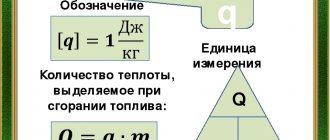Coal pyrolysis products
So, at the very beginning of our article, we mentioned that by pyrolysis from coal you can obtain the following types of products:
- Solid
- Liquid
- Gaseous
Now let's look at each type of pyrolysis product in more detail.
The pyrolysis of coal produces hard coke, which today is used mainly in industries such as ferrous and non-ferrous metallurgy. Coke is a more advanced solid fuel than coal, which is why it is used for metal smelting.
However, coke, although it is the main product of the pyrolysis of coal, is far from the most valuable thing that can be extracted from this natural resource. A by-product of this process is a vapor-gas mixture, which contains many chemical compounds. This mixture is separated by condensation into liquid and gaseous components, from which, in turn, more than 250 chemical compounds can be obtained.
The main liquid product of coal pyrolysis is coal tar, a black liquid product that is a complex mixture of organic compounds. Substances such as:
- Phenols
- Naphthalene
- Anthracene
- Various heterocyclic compounds
- Technical oils
- Synthetic fuel
However, it is worth noting the fact that oils and liquid fuels obtained by pyrolysis of coal are unsuitable for use in internal combustion engines, since they contain many impurities. For this reason, these pyrolysis products require additional purification for further use. And this significantly increases the cost of these pyrolysis products, making their production not very profitable.
The gaseous product of coal pyrolysis is the so-called pyrolysis gas, which is a mixture of flammable gases and various chemical compounds. In many countries around the world, pyrolysis gas is today used as an alternative source of energy, primarily thermal.
While this technology is quite new for us, in some European countries pyrolysis gas has long become a common fuel. In addition, pyrolysis gas, like coal tar, can be used to produce various chemical compounds. Thus, benzene, phenol and other substances are isolated from this gas.
- Comments on the article
Contents of the second block
Introduction to pyrolysis technology
When choosing the optimal technology for yourself, you will come across such concepts as: incineration, sorting, production of secondary plastic granules, production of crumb rubber, waste recovery, pyrolysis and others. Initially, it is necessary to study the vector of movement of the legislator, and it is directed towards waste disposal.
The term recycling means the process of regenerating an original product that has become obsolete or has lost its consumer properties, or obtaining new products from waste, use after processing, etc. Areas such as neutralization or disposal do not receive support in the form of a disposal fee or disposal fee and should gradually be reduced to the minimum required value.
Having decided on the direction of waste disposal, it is necessary to understand the logic of the enterprise ecologist, who is the key person when concluding an agreement for waste removal/supply of raw materials.
Suppose you decide to start producing crumb rubber and even find a sale for it (this business can only be started if there is a sales channel to municipal or federal facilities where rubber coatings are required).
Come to an ecologist of a large enterprise and offer to take away several types of tires for recycling, which corresponds to approximately 5 codes according to the FKKO (each type of waste has a specific code. There are about 3300 such codes). Naturally, the ecologist already has companies with which he works. Logistics, relationships, etc. have been established. The psychology of an employee is to do nothing and get paid on time.
Hence, the ecologist is looking for a recycling organization that has a license to accept the largest amount of waste, ideally - all 3300 in any volume! Of course, there are no such things and there are other levers of influence, but producers of only crumb rubber have serious difficulties in supplying themselves with raw materials, often collecting waste from recycling organizations, without receiving remuneration or even paying extra for collecting tires, not to mention the double logistics burden... But let’s move on to pyrolysis . This technology allows the disposal of a wide range of hydrocarbon-containing waste, in an amount of more than 200 FKKO codes.
To begin with, I want to give my simple definition of pyrolysis in relation to waste disposal. Pyrolysis separates the raw material into dry residue and volatile substances. But if wet soil in a pan on the stove can be divided into water and dry soil, then hydrocarbons require a temperature significantly higher than 100 degrees. And if, by analogy, it is necessary to divide the scorched earth into oil and soil, then the boiling point of the oil will coincide with its self-ignition temperature and spontaneous combustion will occur. Hence, it is necessary to exclude the access of oxygen, i.e. make the process hermetically sealed and this will be the same pyrolysis.
After a year of reading scientific literature and our own experiments using a fire extinguisher cylinder as a crucible, we began to select equipment. This is where the fun started.
Among Russian manufacturers, we found only installations with static crucibles (retorts). But, being well-read, they identified them as a classic charcoal kiln from the 50s of the last century. The main problem with static crucibles is the lack of a function for turning the raw materials during the process. It can be compared to rotating a skewer when cooking shish kebab or stirring porridge and soup.
To fully understand the process inside the retort, remember how the fire from the wood in the fireplace burns and mentally extinguish it so that only smoke comes out - this is pyrolysis. Now let’s remember that wood placed vertically in a fireplace stands straight until only cinders remain, and when the flame goes out, they fall apart. The end of combustion is the end of the release of volatile hydrocarbon compounds and the beginning of the oxidation of coal carbon. At this moment, the pyrolysis process ends, and the resulting carbon becomes ready (this is important!).
Now let’s remember how in childhood we set fire to a plastic bag and how it began to drip and burn. Let's strain our memory and remember that after some time the falling drop stopped burning, although it had not yet turned into coal. And here, as they say, the dog rummaged.
When the crucible is filled with various hydrocarbon wastes such as tires, plastics, oil waste, etc., they sinter into a kind of puddle or coma, and then the pores become clogged during external scaling. A thick heat-insulating coat is formed and hydrocarbons remain inside it.
As you might guess, the pyrolysis process in this case lasts a very long time and is sluggish, and the resulting dry residue contains a layer of hydrocarbons (such as bitumen or fuel oil). This residue has a pungent odor and is not suitable for use. Here, you can make the first professional conclusion for yourself when choosing a pyrolysis installation: if the carbon after pyrolysis has an odor, this technology is unsuitable!
We had the practice of setting up and modernizing similar types of installations from well-known manufacturers. According to the passport, the retort should have a capacity of up to 2 tons. Of course, the prefix “before” immediately confused us, but we had the installation at our disposal and began to launch it.
The retort was a cylinder of 1.2 m and a height of 2.5 m. 8 cargo wheels fit into this lying dimension, which amounted to about 480 kg. Then I did a little math in my head and realized that to load 2 tons it is necessary to make circles of 1.2 m from a sheet of rubber and stuff them inside under the lid...
Previously, the buyer of this installation showed a pile (precisely a pile) of coal mixed with steel cord from tires and complained about the stench, oily inclusions and the sticky substance sticking to the wire and coal. I added a dry residue readiness controller and started heating with a liquid fuel burner, after 40 minutes we switched to our own gas.
According to the buyer, the commissioning engineer of the equipment supplier turned off the gas burner 8 hours after the start of heating and released the remaining gas into the torch, saying that the process was over. I was determined to completely release volatile compounds and decided to carry out the process to the end...
The next morning came... at the end of 18 hours of pyrolysis, the release of gases finally ended (at that time we had been using our installation with a rotating reactor drum for a long time, where pyrolysis lasted 12 hours when loading 8 tons of tires!). We worked 2 shifts, processed 480 kg of tires, received about 200 liters of fuel (pyrolysis liquid), of which we burned about 40 liters for our own needs.
But this is not yet a full production cycle. Next, we disconnected the retort, moved it with a crane beam to cool for 12 hours, then again put the crane beam on the tipper, opened the lid and poured its contents into a jar, raising a mushroom of dust throughout the entire area (try at least turning the glass with soot upside down to imagine dusting ).
Then the workers, swearing to themselves, who had vowed to work here for the last day, began to systematically pull the cord out of the pile of carbon. The process of filling this heap into containers had not yet been mastered, so big bags were raked with shovels. The problem with the cord was its low density of wires sticking out in all directions, which made it extremely difficult to fill the same big bag, as, for example, it would be branches.
Here we can draw one more conclusion: it is necessary to choose not a pyrolysis installation, but a complete production line, starting with the loading of raw materials, ending with the packaging of each product separately in containers for release! Based on the current productivity and labor costs, I concluded that at least 8 sets of equipment are needed and for each of them you need to purchase an additional replacement crucible. The original equipment seemed to have a reasonable price, something like 3.5 million rubles. (but without VAT), however, it is necessary to purchase additionally: a crucible for 500 thousand rubles, a beam crane for 1 million rubles, a tipper for another 500 thousand rubles, packaging and separation devices, to carry out construction work... - total for 5-6 million rubles. runs for a productivity of 500 kg per day.
Some will say that the retort can be loaded much more densely - we did just that, filling the void in the middle of the tires with gas masks. The total weight was about 700 kg, pyrolysis had been going on for 22 hours. The conclusion is the following: they will try to smear your idea of loading the crucible more densely with the proposal to grind the waste or press it inside with counter-arguments, but not with the truth.
In fact, the description of the crucible “technology” or, as it is often called, “pans” (the thing you need for preparing army soup) is of concern to a very small number of buyers, and all of the above applies to beginners or start-ups in the waste disposal business, whose goal is precisely to recycle waste and earn money not only from fees for waste disposal, but also from the sale of processed products.
In most cases, such installations are purchased by “office recyclers” who simply act by purchasing the installation for the sake of accompanying documentation, which includes the most important document, the Positive Conclusion of the State Environmental Expertise (SEE) with a huge list of waste. Based on the documentation, they receive a recycling license and begin to actively collect plastics, tires, oils, rags, oil sludge, etc. Then they are thrown “under the rug” and the business is done. Only in Yekaterinburg we have about 5 pyrolysis plants besides ours, which we don’t even know about.
Conclusion: you need to make sure whether the operating organizations of the equipment whose supplier you like are selling pyrolysis products (how much are they willing to sell per month). Fortunately, the situation is gradually changing, and representatives of RosPrirodNadzor have begun inspections of such pseudo-processors. At this point, I think, the topic of replaceable crucibles is sufficiently covered and its conclusion is that the use of static pyrolysis installations is limited to raw materials that are not subject to “melting”, for example, to use only wood and liquids.
As a result, we did not find the necessary technology in Russia, we only discovered that Chinese equipment of the required technology was being outbid, but many people already knew the Alibaba.com website, so we immediately moved on to searching for manufacturers from the Middle Kingdom.
I note that Europe was previously also considered, but the beginning of prices at 900 thousand euros plus delivery and installation immediately sobered us up. On Alibaba we found a countless number of manufacturers at very different prices (by the way, not a single retort unit was on sale. They explained to us that they have not been produced for 25 years). Most offered drum-type reactors (concrete mixer principle). The rest offered screw flow pyrolysis installations.
Screw pyrolysis installations at first glance seemed simply amazing, because... the process runs linearly, continuously, with high productivity - in general, a feast for the eyes. But further study reminded me of a video from Yeralash about a Japanese smart watch, which the guy exchanged for a player and, in addition to the watch, gave away 2 suitcases of batteries.
And here’s the thing: for installations of this type it is necessary to use crushed raw materials. For example, tires must have a fraction size of less than 50x50x50mm. Previously, it was necessary to prove the high energy consumption of equipment for shredding the same tires, but now there is a GOST (I don’t have the number at hand, but I’ll find it if you ask), which indicates a figure of 600 kWh per ton of shredded tires. Just imagine what a set of equipment and manual labor is needed with so many electrical appliances. Unfortunately, the video of a shredder shredding tires is much more staged and was not filmed the first time. Therefore, they first propose to pull out the bead ring, then chop it into pieces and only then grind it with a shredder.
There are other nuances, the plastics are wound around the “screw”, and if a wrench gets there, the installation will fail because has a friction pair of the screw feeder with the wall pipe. Also, Russian workers are famous for having only two tools: a sledgehammer and welding. And the use of a continuous pyrolysis cycle installation requires high-level specialists, such as engineers and technologists.
Taking into account the installation of such an installation somewhere “out on the outskirts”, it is equivalent to buying a Ferrari in the village and servicing it on site. In this case, installations with a rotating drum using solid tires have strong arguments to be more practical, although they have a significant drawback - cycling, which, however, can be compensated by using several installations at the same time, which will still be cheaper than purchasing a continuous pyrolysis installation with a set of equipment for waste grinding.
For ourselves, we completely understood the simplicity and exceptional efficiency of the rotating reactor, which is one-on-one reminiscent of a concrete mixer into which even if you throw a crowbar, nothing will jam. The rotating drum turned out to be multifunctional and, in addition to turning the raw materials during pyrolysis, performed a number of functions. Thus, the metal cord, when rotated, is interlocked with wires and, according to the snowball principle, forms a single lay at the end of the cycle, completely separated from the dry carbonaceous residue. Heated metal at a high temperature becomes soft (the metal cord in tires is made of alloy steel with spring properties, which makes it difficult to briquet when cold) and due to this its twisting density is comparable to a rope (it is impossible to stick a knitting needle). When rotated, the twisted cord also creates the effect of a ball mill, continuously grinding the raw material inside the reactor like a whisk, maximizing the pyrolysis process. Hence, there are no restrictions on the loading density (how much power the loading press has, you can push), the thickness of rubber, plastic, briquettes, oil sludge clogging, etc. The reactor drum is also equipped with a spiral inside, welded directly to its shell from the inside, providing fast, mechanized discharge of carbon from its axis of rotation (again, like in a concrete mixer) without dust directly into the container. Next, the lay of the steel cord is unloaded by a winch using a harpoon. It is immediately ready for loading into a scrap truck without any additional processing. The main thing is that its density is high enough to transport and receive the expected price for scrap metal. Having strengthened our confidence in choosing the right technology by watching numerous videos and printed information in foreign sources, we went to the Chinese province, where about 30 equipment manufacturers are concentrated. I’ll add that at that time, we checked the cost of dark heating oil and light heating oil from Pultsen. The difference was 50% and it was decided to purchase an additional distillation unit (distillation column for secondary distillation of fuel), and at the same time a fuel desulfurization line. No matter how theoretically and technically savvy we were, it was extremely difficult to choose the right installation. The Chinese welcome dozens of visitors every day and it was simply impossible to ask an awkward question. It was a one-goal game, comparable to deceiving a gypsy in a gypsy tabar. They met us, gave us water, fed us, drove us around, took us to attractions, talked to us and did all this rather so that we would have less time to visit other manufacturers. However, we looked at about 5 factories, it is not possible to distinguish them from each other, despite the differences in the methods of supplying raw materials, unloading, type of loading caps, etc. Without operating experience, it was not possible to evaluate the advantages of a particular system. Now, of course, we can give a review of each model of equipment, but the point is that we were only shown the pyrolysis process itself and were fascinated by the liquid running in the flask. Conclusion: you shouldn’t go to China to choose equipment - ask for contact information of buyers where you can see it in action. And so we decided on the seller and were warned by one person that it was not worth bargaining with the Chinese, because... they will agree to a discount, but in their minds they will already throw out some element or replace the steel at the ends of the reactor with a cheaper one. We also had no idea in what completeness and degree of readiness the equipment was supplied - this was a serious mistake. As a result, we purchased all the necessary equipment, but upon delivery we overpaid a huge amount for the downtime of reactors sent on an open platform while waiting for sea containers sent by another route with a time delay. Customs officers were ready to inspect the cargo only as a whole. We also had to issue a delivery certificate and prove that all equipment units belong to each other... In February 2013. Installation has begun. The contents of the packages were opened and everything looked like a DIY kit. The only thing that was manufactured more or less completely was the reactor itself, but the combustion unit initially consisted of 3 pallets of bricks and grates with doors. The rest of the nodes looked also depressing. Everything looked as if, in the midst of manufacturing the equipment, it was simply picked up and sent to the customer. I have never seen such quality components before. In all products and pipelines, 3mm thick sheet metal was used, products such as ball valves, gearbox housings were made of some kind of powder steel, the thickness of the flanges did not exceed 10mm, the rotating bodies had visible runout. It was impossible to start assembly without a Chinese technologist, since there was no accompanying documentation whatsoever. The entire cargo consisted more of rolled metal and spare parts than equipment. In February 2013 installation has begun. The Chinese technologist used a tape measure to measure where to dig, where to pour, etc. I will add that the installation was carried out at our own construction site, where there are all services from small-scale mechanization and turning, to the production of concrete and products made from it. Also towering above the site was the SKG crane. And even with this power, we were tired of driving an excavator and a concrete mixer back and forth, and we made a little project from the words of the Chinese in order to streamline the work. Only September 1, 2013 It was possible to carry out the first start-up of a pyrolysis unit, a distillation unit and a pyrolysis oil desulfurization line. And this was just the beginning of the journey... The declared capacity of the pyrolysis unit was 10 tons per day for tires. In fact, we managed to load 3.5 tons (we purchased the most complete set with all the mechanisms). It was possible to carry out only 1 cycle once a week. In general, the Chinese retreated completely, and the manufacturer completely abandoned us. The equipment was installed without taking into account internal logistics, which interfered with the movement of materials and this is irreparable. There were so many problems that it took us a year and a half of daily modifications and more than a dozen tons of metal structures were thrown into a landfill. In fact, we had to replace all the mechanisms, all the shut-off valves, come up with a number of devices, develop technological regulations, instructions, maintenance, etc. etc. If the initial average monthly productivity turned out to be 22 times lower than declared, then after a while the load reached 8 tons and 15 production cycles per month. It was possible to carry out pyrolysis daily, but it turned out to be too energy-intensive to cool the reactor in a short time. The work went like this, 19 hours for all production cycles and the next day the reactor was cooled.
Now about pyrolysis products. Russian manufacturers of pyrolysis units forced the purchase of distillation columns for the production of diesel, gasoline, fuel oil, etc. from pyrolysis oil. We fell for this trick and purchased the appropriate installation, but quickly switched it to distillation of waste oil (waste oil), because... the quality of the pyrolysis oil was excellent and it was used on burner devices of all types (not only for heavy fuels, like oil from domestic installations). The desulfurization line was also not used, because sulfur in the fuel was about 0.3%. Later, while doing research work, we came across a study in which it was said that there are no diesel or gasoline fractions in pyrolysis oil - there are only hydrocarbons that are similar in a number of parameters. This did not upset us in any way, because the price of our fuel was fixed at 50% of the price of diesel fuel and no additional manipulations were required. But pyrolysis oil obtained “straight-run”, i.e. without any tricks, exclusively single-stage condensation in heat exchangers, has low quality indicators and corresponds to fuel oil. The price of fuel oil is 2 times lower than the cost of fuel for diesel burners and its sales are specific. In particular, it is used by large enterprises and boiler houses, and sales are carried out in the volume of railway tanks and trains. This is where the myth of the “hidden potential” of pyrolysis fuel comes from. You can read more about marketing pyrolysis products in our other blogs.
To be continued…
Equipment for the production of
The basis of the production process for the production of charcoal is the following mechanisms:
- Device for splitting firewood using hydraulics.
- Chainsaws.
- Scales.
- Charcoal kiln.
- Electricity generator.
To construct the furnace, an open and level area should be equipped; the furnace itself must be of high quality, ensuring that oxygen cannot penetrate. Otherwise, some of the raw materials will not be processed, but will burn.
Video: furnace for making charcoal.
A good furnace is designed in such a way that the gases produced during oxidation are fed into the firebox, burned there and directed to maintain the required temperature. This energy saving is environmentally friendly and economical.
There is also equipment in which it is possible to use only one container. In this case, the process of continuity of technological production of charcoal is disrupted and downtime occurs. This situation is solved by the presence of removable containers in which you can separately dry, oxidize firewood and leave it to burn out.
Modern technologies used to make charcoal are waste-free, environmentally friendly and ergonomic. The equipment does not require additional or specific maintenance. In production, as a rule, 3 people work, responsible for the continuity of the process and the automatic adjustment of machines.
The equipment differs in its variability, but they can be grouped into 3 main types:
- Mobile installations;
- Stationary mechanisms;
- Auxiliary equipment.
The first and second groups of equipment differ from each other in the presence and absence of the ability to transfer it. Moreover, some types of equipment have a single function for performing drying and pyrolysis.
Charcoal kilns weigh from 6 to 80 tons. When choosing mobile equipment, you should choose small models that will allow you to change their location. The choice in their favor is due to the lack of opportunity to systematically supply consumables to a specific location. Mobile units consist of modules and are quickly assembled and dismantled. They can be located without creating additional canopies and protective spaces.
Stationary installations, on the contrary, require the allocation of a separate adapted room, which can be used simultaneously as a storage facility for finished products.
Installation of equipment must be carried out by specialists and comply with the provisions of GOST. All installations must meet safety and environmental requirements, since waste and carbon residues are burned in the furnaces.
Auxiliary equipment is desirable to purchase because it significantly reduces costs, primarily of a temporary nature. These types of mechanisms include a weighing and filling dispenser and a separator.
Advantages and disadvantages of pyrolysis type boilers
In gas generator boilers, fuel is used most efficiently, since it burns almost completely. This not only allows you to get more heat, but also reduces harmful emissions into the atmosphere.
Sometimes such boilers are used to dispose of industrial waste with minimal air pollution. In addition, the amount of ash is reduced, which means less cleaning frequency (when using firewood - about once a week).
When burning solid fuel directly, it is quite difficult to regulate the heating of the coolant. In long-burning pyrolysis boilers this is possible thanks to air supply control.
The size of the firewood used can be quite large; uncut firewood can be used. Modern models are equipped with electronic equipment that makes controlling the heating process simpler and more convenient.
Disadvantages include the high cost of equipment and high requirements for the quality of raw materials. Fuel savings will pay for the equipment costs over time. It is recommended to use firewood that has been dried for 12 months with a humidity of 12-20% as fuel.
Otherwise, the boiler will not work with the declared power, and will also go out when the air supply decreases. If the coolant temperature in the return pipe is low, the temperature in the primary chamber will drop, which may cause the fuel to go out.
To avoid this, sometimes a special bypass pipe is installed. At the same time, the design of the heating system becomes more complicated, and the installation cost increases.
Using forced draft
To ensure proper operation of a long-burning pyrolysis boiler, a supply of primary and secondary air is required. Forced draft is provided by a fan or smoke exhauster, which operates from power supply.
This allows:
- quickly increase the temperature in the combustion chamber and the heating system as a whole;
- accelerate the start of the pyrolysis process;
- extend the operation of the boiler on one load of fuel;
- automatically maintain the coolant temperature.
The only drawback is the need for constant power supply. If it is absent, the operation of the heating system is suspended. A way out of the situation may be to use a boiler with natural draft, which does not require connection to the electrical network.
For its full operation, a properly designed and installed chimney is required. Such boilers must be cleaned more often. Due to the absence of electronics, the likelihood of breakdowns is minimized. However, the operating efficiency of such boilers is lower, which is compensated by their lower cost.
The use of pyrolysis boilers running on solid fuel is one of the most effective ways to organize autonomous heating. Modern electronic equipment that controls the work process allows you to automate the heating process.
The lack of gas or insufficient power of electrical networks forces homeowners to solve the problem of winter heating with the help of solid fuel equipment. Among these units, long-burning pyrolysis boilers stand out as a separate group (the second common, although not entirely accurate, name is gas generator). The reason for this is their high efficiency - up to 85% and the large power range of the device - from 30 to 100%.
Prospects for the development of pyrolysis
When using catalysts, the cracking process increases sharply and the yield of products increases. In this case, difficulty is caused by the emerging process of coking of the catalysts themselves. Scientific developments in this direction are underway.
The use of process activators or inhibitors that inhibit secondary reactions is also at the experimental stage. But this method of process optimization is also difficult due to contamination of the output product. Currently, methods are being developed to physically accelerate pyrolysis using electromagnetic fields.
In everyday life, heating furnaces based on cracking are becoming widespread, consisting of two chambers, in the first of which sublimation occurs by cracking, and in the second the combustion itself takes place.
How to properly fire a pyrolysis combustion boiler with coal
- Ignition of a pyrolysis boiler on coal - with the damper fully open, ignite the coal. It is prohibited to use kerosene, gasoline or other compounds that can quickly ignite a flame. A small amount of dry wood is used for ignition.
- Transferring the boiler to pyrolysis mode - after heating for 15-20 minutes, close the damper and switch to pyrolysis mode. From one start, the boiler continues to operate for up to several days.
Which coal is better for pyrolysis boilers?
high temperature
The design includes a top-loading firebox made of thick-walled steel or cast iron. Despite changes in the internal structure, the pyrolysis boiler must be heated exclusively with the coal whose grade is indicated in the technical documentation.
Separate requirements apply to the fraction size. It is better to fire automatic boilers with fine coal from 0.5-2 cm, this is due to the peculiarity of the screw fuel supply.
- Anthracite – based on anthracite coal, most modern models of heating equipment operate. Coal has good calorific properties and a small ash residue.
- Hard coal – the use of hard coal in pyrolysis boilers is also justified. This type of fuel is the standard for calculating the destructive capacity.
- Brown coal has a high ash content, as a result of which the grates are often burned out. It is possible to use brown coal in a pyrolysis boiler only if there is an air preheating system before feeding it into the furnace. The use of high-ash and wet rock varieties is prohibited.
- Long-flame coal – supplied in slabs and large fractions. It got its name due to its ability to burn with a long flame, like wood. At the same time, the burning time of long-flame coal is longer, approximately 2-2.5 times, compared to firewood.
- Coal briquettes are made from coal waste by pressing and adding cementitious compounds. Briquettes flare up quickly and have good calorific characteristics. As advantages, they also highlight the almost complete absence of ash residues and slags.
optimal types
Coal consumption in a pyrolysis boiler
environmenthard frostwarm winter
Calculations are performed as follows:
- The heated area is calculated - for this, the length of the house is multiplied by its width.
- Calculate the required boiler power using the formula 1 kW = 10 m².
- Calculate the costs for the heated area. The average cost for the heating season will be 550 kg for every 10 kW of boiler or 100 m².
- The resulting value is multiplied by the number of months of the heating season.
Manufacturers indicate in the technical documentation how long the boiler will operate on one bed of coal, list all types of fuel acceptable for use, approximate consumption and other characteristics.
Choosing a brand of pyrolysis coal equipment manufacturer
domestic market
- Heating pyrolysis coal boilers made in Russia - manufactured products are adapted to domestic operating conditions and are unpretentious in terms of fuel quality. The most popular models are Trajan, Geyser, Divo.
- Varieties of imported coal pyrolysis boilers - heat generators produced in EU countries are made of steel or cast iron. A combined design is allowed, when cast iron grates are used together with a steel heat exchanger. The products are distinguished by high reliability, full automation of the combustion process and long service life. The model range of companies is popular: Buderus, Atmos, etc.
Russian boilers
Application of the method in the Russian Federation and in the world
The first pyrolytic enterprises in Russia opened in the last decades of the 19th century. Kerosene was processed there. The resulting products were used to make gas for lighting. The first patent for this method was received by a scientist from St. Petersburg. During the First World War, toluene, a raw material for TNT explosives, was created using the pyrolytic method.
Pyrolysis waste processing plants are located all over the world. Gas, as one of the recycling products, is a source of energy for heating water and heating. Ethylene and propylene are produced using high-temperature processing. The leader in creating a product for producing ethyl alcohol at this stage is the USA. They extract more than 27,000 tons of this substance in 1 year. In Russia they receive 3,000 tons.
Pyrolysis is more popular in the world than in the CIS countries. This is due to the high cost of installation and technical difficulties of operation. New enterprises are not being built; old ones, preserved from the times of the Soviet Union, are being reconstructed.
Pyrolysis equipment for waste processing can be easily purchased on the Internet. The price for one installation starts from 10 million rubles.
The high-temperature processing method has long gone beyond the industrial field. You can find ovens with eco-pyrolysis function. The essence of the mode is that for simultaneous preparation of a large amount of food, a minimum of energy is required.
How to choose a pyrolysis boiler
The market provides a wide choice to the buyer. Most of the units are the creation of Czech manufacturers, but German representatives hold the lead. Almost all models require power supply; they can run on coal, wood, or a combination.
When choosing, you should pay attention to:
- unit power;
- external design;
- number of circuits.
When purchasing such a heating device, you need to choose the right power so that there is enough heat for the room. The guideline is as follows: 1 kW of power of a pyrolysis boiler is required to heat 10 square meters. m of premises. This takes into account the fact that the house is well insulated, the height of the walls does not exceed 3 meters. If heat losses are possible at home, the buyer is not sure of the reliability of the building, then not 1 kW, but 1.3 kW is taken into account. For example, for a room of 30 square meters. m we need a pyrolysis unit with a power of at least 3.9 kW (1.3 kW * 30 sq. m / 10 = 3.9 kW).
Pyrolysis boilers are technological devices, they have a large number of electronics and various settings; the more expensive ones have a control panel and a ceramic firebox, which allows you to retain heat for a long time, with good technical characteristics. You can also find newer models: a pyrolysis boiler in a cast iron body (German manufacturer Dakon).
There are also models that can still function without electricity. These are OROR (Czech) boilers. The essence of their work is as follows: the formation of gases occurs during the pyrolysis of fuel; their path passes through a diffusion-type burner, where they are directed to the combustion chamber.
Combustion occurs thanks to secondary air. Secondary air is not amplified by a fan and is not directed to the combustion chamber, unlike most models; it is sucked into the chamber during the movement of gases. This is facilitated by a special perforated tube. By opening the secondary and primary air valves, the boiler power is regulated. Such models operate completely autonomously and guarantee an efficiency of 89%.
Autonomous heating systems are relevant primarily where there is no possibility of connecting to the main heating supply. One of the modern types of such systems are solid fuel pyrolysis boilers, which have a long combustion period.
The various models available for sale differ in power, configuration and price. Such boilers have high efficiency and minimal emissions of combustion products into the atmosphere. The ability to automate control makes their use more convenient.
The essence of the pyrolysis boiler
Such a pyrolysis boiler is also called a gas generator boiler. The essence of the work is in the pyrolysis combustion of fuel: under the influence of high temperatures and in conditions of lack of oxygen, solid fuel (brown coal, coal briquettes) is broken down into volatile particles. This produces so-called pyrolysis gas. The heating temperature of the equipment is 200-800 degrees. This chemical reaction promotes better heating and drying of the fuel in the boiler; heating occurs, which goes in the direction of air combustion.
Rice.
2 High temperature promotes mixing of oxygen with the released pyrolysis gas. As a result, the gas burns. Thermal energy is generated from burning gas. It should be noted that pyrolysis gas also interacts with active carbon during its combustion. Therefore, when leaving the boiler, the flue gases have virtually no harmful components. Rather, they are a mixture that includes carbon dioxide and water vapor. The resulting CO2 enters the environment three times less than after the operation of conventional coal or wood boilers. These units are considered environmentally friendly and do not pollute the environment.
Units of this type operate on coal and wood fuel. If you use poor quality raw fuel, the heater will lose its power by up to 50%. Such fuel burns poorly, smokes, heats little and shortens the life of the boiler and chimney.
Advantages of pyrolysis units:
- power adjustable from 30% to 100%;
- the cleaning and maintenance process is simple;
- low fuel requirement;
- fuel supply only once per day;
- a large amount of fuel burns together at once;
- use of raw fuel with a coal boiler, the humidity of which is not higher than 20%.
Flaws:
- expensive heating device;
- need electricity.
Each type of fuel burns differently. As for coal fuel, brown fuel burns out in 8 hours, and black fuel in 10 hours. With pyrolysis boilers, savings are possible, even taking into account such disadvantages as the need for electricity, but not at low cost. Electricity is needed to power the fan, but it only requires 85 watts (like a regular light bulb) to operate. If this is a problem, then a diesel generator can handle it.
Processed products
The volume and type of pyrolysis products vary. The material that was processed, the amount of raw materials, the duration and temperature of the process play a role. As a result of combustion, the following pyrolysis products are formed:
- pyrolytic oil;
- electrical and thermal energy;
- diesel fuel;
- pyrogas;
- Picarbon is a solid residue that is essentially charcoal.
Pyrolytic oil is used as furnace fuel. In fact, it is an analogue of fuel oil. The product is also used as raw material for recycling.
All these products should be obtained in theory. But in practice this cannot always be achieved. To obtain diesel fuel, it is necessary to carefully separate the waste. It is almost impossible to extract raw materials from unsorted residues.
Advantages of pyrolysis-type heating units
- In addition to high efficiency and the ability to control power, the advantages of this equipment include a long combustion duration with one fill.
- Highly environmentally friendly: the combustion process proceeds until the fuel is almost completely decomposed into neutral substances - water and carbon dioxide, chimneys are not overgrown with resins. There are negligible by-products of gaseous harmful substances.
- No smoke in the room. There is no soot formation, the amount of ash generated is minimal. Simple automation makes it easy to operate the unit.
- A variety of fuels: wood, wood waste, coal - this is the advantage of boilers.
- Does not require frequent maintenance: combustion products do not pollute the unit, but periodic cleaning will be required. High-tech automation monitors faults and prevents their occurrence.
Garbage processing stages
Before burning waste, it is prepared: crushed and dried. Drying is the process that requires the most energy. When processing wood, it is dried to 15%. In addition to removing water from the wood, some components are replaced.
Only after preliminary preparation do they begin to pyrolyze the waste. The most unstable parts of the garbage decompose first. Their splitting occurs at temperatures up to 300°C. At this time, acetic acid, carbon dioxide and carbon monoxide are released.
When the temperature rises above 300°C, most of the solid waste decomposes.
This process is exothermic, that is, it is accompanied by abundant heat. Methanol, hydrocarbons, ammonia, and ethers are actively formed.
At the last stages of pyrolysis of waste paper and other wood residues, the substances remaining in the installation are calcined. At this moment the temperature reaches 500°C and continues to rise. A resin with a high molecular weight and volatile gases are released. For example, hydrogen, carbon dioxide and carbon monoxide. The end result is charcoal.
CLAIM
1. An installation for producing charcoal, characterized in that it is made in the form of a horizontally oriented body with fire-resistant end and side walls, divided by vertically oriented fire-resistant partitions into at least one combustion block, at least one pyrolysis block and a block exhaust gas removal, at least one pyrolysis gas collector is located in the lower part of the housing, and in the side walls and/or partitions of the housing there are channels for the vapor-gas mixture, exhaust gas removal, secondary air supply and water vapor circulation, while the combustion unit is made in the form of a combustion chamber with loading openings and dampers that regulate the supply of primary air, the pyrolysis unit includes at least two cells formed by the walls of the housing and/or vertical partitions, with at least one retort located in each cell, equipped with an outlet pipe, the vapor-gas mixture channel is connected on one side to the combustion unit, and on the other hand to the pyrolysis block, the exhaust gas removal channel is connected on one side to the pyrolysis unit, and on the other side to the exhaust gas removal unit, the secondary air supply channel is connected with the exhaust gas block, the water vapor circulation channel is connected on one side to the pyrolysis gas collector, and on the other hand to the exhaust gas removal block, while the pyrolysis gas collector is connected on one side to the outlet pipe of the retort, and on the other side is connected to the combustion unit .
2. The installation according to claim 1, characterized in that in the walls of each cell of the pyrolysis unit there are holes for connecting the cell cavity with the channel of the vapor-gas mixture and the channel for exhaust gases.
3. Installation according to claim 1, characterized in that the cell of the pyrolysis unit is equipped with a sealed fireproof lid.
4. Installation according to claim 1, characterized in that the exhaust gas removal unit is made in the form of a chamber formed by the walls and/or partitions of the housing, with openings connecting the chamber of the exhaust gas removal unit with the channels for supplying secondary air, water vapor, and exhaust gas removal.
5. Installation according to claim 1, characterized in that the inlet of the secondary air supply channel is located in the end wall of the housing, and the outlet is in the wall of the exhaust gas removal unit.
6. Installation according to claim 1, characterized in that the water vapor circulation channels are located in the secondary air supply channels.
7. The installation according to claim 6, characterized in that it is equipped with a two-way valve designed to cut off the water vapor circulation channel from the pyrolysis gas collector.
8. Installation according to claim 1, characterized in that the cells of the pyrolysis unit are made of a square horizontal section.
9. Installation according to claim 1, characterized in that each retort is located in the central part of the cell with a gap from its walls of no more than 0.4 m.
10. The installation according to claim 4, characterized in that the volume of the combustion chamber of the combustion unit is no more than 37% of the volume of the cells of the pyrolysis unit and no less than 110% of the volume of the chamber of the exhaust gas removal unit.
11. Installation according to claim 2, characterized in that the area of the holes for connecting to the vapor-gas mixture channel of each cell is no more than 140% of the cross-sectional area of the vapor-gas mixture channel.
12. The installation according to claim 1, characterized in that the retort of the pyrolysis unit is made in the form of a body with a bottom, a lid and a cylindrical side wall, equipped with a gas outlet pipe connected to a pyrolysis gas collector, while the side wall is made multilayer, and the gas outlet pipe is mounted in the top of the side wall.
13. Installation according to claim 1, characterized in that the side wall of the retort is formed from at least one metal sheet rolled into a roll, or from two metal cylinders coaxially placed with a technological gap.
14. The installation according to claim 1, characterized in that it contains a filter unit, a smoke exhauster and a chimney connected in series through an outlet pipeline to the exhaust gas removal unit.
Wood pyrolysis
This procedure is also called wood cracking, and it originated in Russia. The prototype of a modern unit was invented by our charcoal burners back in time. To produce charcoal without access to air, they ignited wood under a layer of earth.
Today this process is much more advanced and takes place in several stages. Cracking begins when heated to 2000 ºС. At this stage, a large amount of carbon monoxide is released. If you continue to burn it in the atmosphere, you will be able to obtain a huge amount of energy.
Then the boiler heats up to 5000 ºС. At this temperature, methanol, resins, acetone and acetic acid are obtained. In addition, solid carbon is produced, better known as charcoal.
Starting the boiler
When starting up a pyrolysis unit, it is worth taking into account the characteristic features in which it differs from classic boilers. The operation of the device in gas generator mode is carried out thanks to two chambers, which are equipped with gates (dampers)
But not everyone remembers that such a heating unit must first be warmed up.
Rice.
3 When the temperature reaches +500-+800 degrees, you can start immersing solid fuel, and only then set the damper to pyrolysis mode and start the smoke exhauster. A pure yellow-white flame (Fig. 3) indicates that the gas generator settings are correct and that there are no toxic combustion products in the smoke mixtures.
This sequence of actions during startup guarantees the combustion of fuel slowly and oxygen-free, effective release and combustion of pyrolysis gas (clean), and a constant comfortable room temperature for 24 hours.
Operating principle of a long-burning pyrolysis boiler
Long-burning pyrolysis boilers are gaining considerable popularity, especially in areas where there is no access to gas
The operation of the equipment is based on the decomposition of organic fuel (wood) under conditions of high temperature and lack of oxygen, followed by combustion of the released pyrolysis gases. Since the process can be divided into two stages, a firebox with two compartments is used to carry it out. Fuel is placed into the loading chamber and begins to burn. The combustion process smoothly turns into thermal decomposition due to the limited access of oxygen necessary for combustion. High temperature and low oxygen concentration lead to the formation of decomposition products: coke and pyrolysis gas. The latter, entering the second chamber, undergoes combustion under the conditions of access of secondary air. It is often supplied forcefully using a blower fan or smoke exhauster. The combustion process occurs at temperatures above 1000°C. Heat is transferred from combustion products to the liquid filling the heat exchanger. The final gaseous products of the process are removed through the chimney. Today, long-burning pyrolysis boilers are considered the most efficient and economical heating equipment. The complex two-chamber structure of the boiler explains its high cost. The efficiency, the maximum among heating units, allows you to get a quick payback for the boiler.
The essence of the method
Recycling organic matter in this way involves converting heavy waste into lighter waste. There is no access to oxygen, an anaerobic reaction occurs. The pyrolysis process is accompanied by an increase in temperature to 200–400°C. The pressure corresponds to atmospheric pressure.
The mechanisms of transformation of substances by anaerobic heating have not yet been sufficiently studied. Conventionally, all pyrolysis reactions are divided into primary and secondary. The first type of transformation is to reduce the molecular weight of compounds. This is how heavy substances are broken down. The process is accompanied by the release of a large amount of gases.
The secondary reaction is the conversion of low molecular weight compounds into heavy ones. This chemical process is characteristic of the last stages of pyrolysis. Gas emissions are reduced. Two types of reactions occur at the same time, so the classification is arbitrary.
In theory, water is pyrolyzed. As a result, hydrogen and oxygen are formed. But in practice, such a task is not feasible, since the required heating temperature is thousands of degrees. This is technically labor intensive and expensive.
Chemists also allow gas pyrolysis. First, the less stable bonds of carbon atoms are destroyed, then the bridges between this microelement and hydrogen disintegrate. According to the pyrolysis formula, methane is the last to decompose.
Charcoal production
The advantage of a business based on the use of very cheap or free raw materials is high profitability and quick return on production.
Nature “produces” wood in sufficient quantities, so a coal production enterprise can operate year-round and at full capacity.
In addition, unlike the wood processing industry, the quality of the raw materials is of little importance, which allows the use of dead wood and trees that are dry and in an upright position.
This article will discuss a detailed plan for organizing a business for processing wood raw materials into high-quality coal for barbecue or for further use for medical purposes.
Our business assessment:
Starting investments – from 300,000 rubles.
Market saturation is average.
The difficulty of starting a business is 5/10.
Principle of operation
Unlike traditional solid fuel boilers, pyrolysis boilers use a double combustion cycle. During the thermal decomposition of organic substances, pyrolysis gases are released, the combustion of which leads to a large release of thermal energy.
The use of pyrolysis allows you to obtain more heat from burning fuel. Pyrolysis (gas generator) boilers have two chambers - for burning solid fuel and the released gas.
In the first chamber, combustion occurs at a low level of oxygen and high temperature (200-800 ° C), this starts the pyrolysis process. The amount of gases released depends on the raw materials used. The best wood is the one that releases the largest amount of pyrolysis gas when burned.
The optimal thickness of firewood is from 70 mm; in addition to them, you can use pellets or sawdust in an amount of no more than 25%, since they do not provide sufficient combustion power. The operation of a long-burning gas generator boiler occurs according to the following scheme:
- The fuel is placed on the grate (fireproof grate) through the loading window.
- Provide primary air supply to it.
- The fuel is ignited and brought to the mode, achieving the required temperature.
- The supply of primary air is limited by closing the valve, due to which the pyrolysis process begins.
- The pyrolysis gas is supplied by a fan to the secondary chamber, where secondary air is supplied.
- Hot gas burns when in contact with oxygen, releasing a large amount of heat, which heats the coolant in the heat exchanger.
- Combustion products are discharged through the chimney.
Depending on the amount of incoming secondary air, the reaction occurs at different rates. This allows you to regulate the coolant temperature using an automatic valve, limiting the air supply to the afterburner chamber.
With optimal quality of burned wood, the efficiency of long-burning pyrolysis boilers is 85-90%. This indicator decreases sharply with increasing wood humidity, as water vapor reduces the concentration of flammable gases.
Process description
Our society has long had a need for environmentally friendly equipment for processing chemical waste. The first pyrolysis boilers began to be launched at the end of the century before last. And the creation of modern pyrolysis units solved several issues at once:
- environmental component;
- the ability to accumulate combustion results;
- economic benefit.
However, the economic aspect of using pyrolysis is designed for the future. Pyrolysis is quite an expensive pleasure. It requires appropriate equipment and specially trained personnel.
But in operation, pyrolysis plants are practically autonomous. The units only require electricity to start; further operation of the boiler is carried out using the resources produced during the combustion process. At the same time, excess generated energy and steam can be used for domestic purposes by redirecting them to utility networks.
In Russia, pyrolysis is just beginning to gain popularity, while in Europe not a single large enterprise can do without pyrolysis plants. There are many reasons for such demand for pyrolysis:
- a waste-free method of processing waste and all kinds of industrial pollution;
- the efficiency level from pyrolysis is 90%;
- the possibility of obtaining new compounds and recyclable materials;
- the creation of non-renewable resources such as synthetic oil;
- obtaining hydrocarbons, organic acids and other chemical elements;
- source of heat supply for enterprises.
Based on the choice of raw materials for processing, the pyrolysis reaction can occur at different temperature conditions. The final result will also differ in the composition of chemical elements.
Depending on the heating temperature of the furnace and the additional components of pyrolysis, distillation is usually divided into two types: dry and oxidative.
